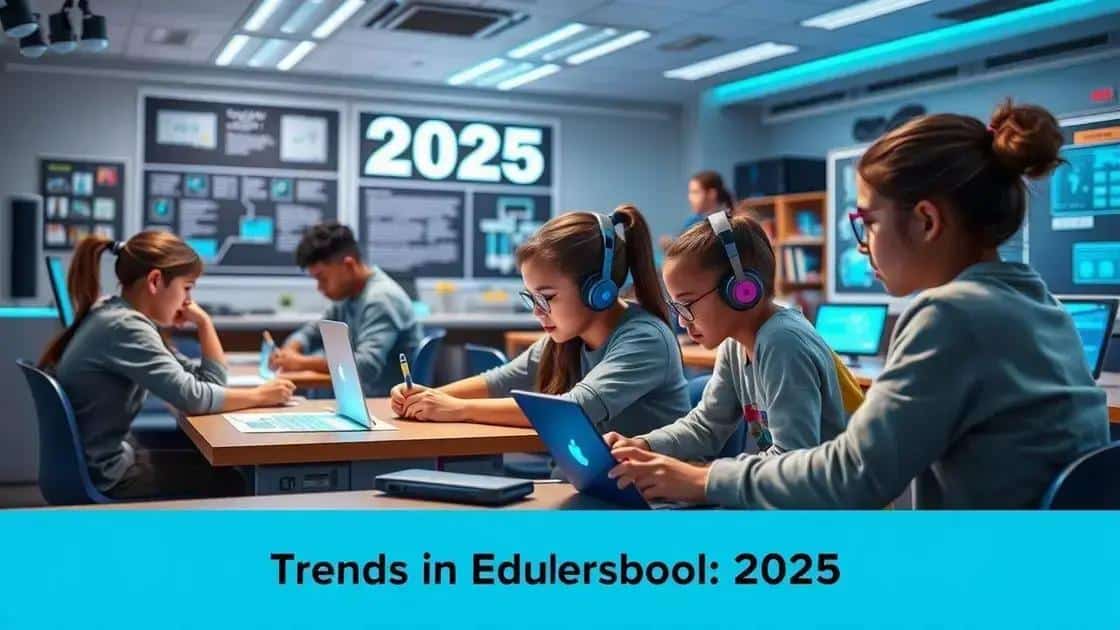Patterns in academic success 2025 analysis

Technology plays a vital role in education success by enhancing student engagement, providing access to diverse resources, fostering collaboration, and allowing teachers to track student progress effectively.
Patterns in academic success are evolving rapidly. As we approach 2025, it’s crucial to understand what contributes to effective learning in today’s educational landscape. Are you curious about the trends that could enhance your academic journey?
Understanding academic success metrics
Understanding academic success metrics is essential for students and educators alike. It allows us to evaluate performance and adapt strategies for better outcomes. Metrics help us define what success looks like in an academic setting.
What are academic success metrics?
Academic success metrics include various indicators that evaluate student performance. These metrics can be quantitative or qualitative, and they give insights into how well students are achieving their educational goals. Key metrics include grades, test scores, and graduation rates.
Common metrics used in education
- Grade Point Average (GPA): This indicates a student’s overall performance across courses.
- Standardized Test Scores: These scores help compare student performance against national or state standards.
- Attendance Rates: Regular attendance reflects engagement and is a vital component of academic success.
- Course Completion Rates: This measures how many students successfully complete their enrolled courses.
When we evaluate these metrics, we can identify areas that need improvement. For instance, if attendance rates are low, schools might implement programs to encourage more consistent participation. Furthermore, analyzing standardized test scores can reveal trends across different demographics, allowing educators to address disparities.
It’s important to note that while these numerical indicators are helpful, they do not tell the whole story. Other factors, such as emotional well-being and support systems at home, play roles in a student’s academic journey. Balancing quantitative data with qualitative insights can provide a fuller picture of academic success.
In recent years, there has been a shift toward holistic metrics that take into account emotional health, social skills, and critical thinking abilities. Schools are adapting by incorporating assessments that measure these attributes, recognizing that success is not just about grades.
Key factors influencing student performance
There are several key factors influencing student performance in academic settings. Understanding these factors can guide students and educators to focus on what truly makes a difference in learning outcomes.
Individual Characteristics
Students come from diverse backgrounds that shape their academic journeys. Factors such as motivation, intelligence, and even health can play significant roles in their performance. A motivated student is more likely to engage with the material and persist through challenges, while good physical and mental health provides the necessary foundation for learning.
Family Support
Support at home can heavily impact a student’s success. When parents are involved in their child’s education, the child usually performs better. Here are some ways family can help:
- Encouraging consistent study habits.
- Providing a quiet and safe space for homework.
- Participating in school events and activities.
- Communicating with teachers about academic progress.
These elements can build a solid support network that fosters a child’s academic growth. Additionally, positive reinforcement can boost a child’s self-esteem and drive while navigating their studies.
School Environment
The atmosphere in which students learn is another critical factor. A positive school climate encourages learning and achievement. Factors such as teacher engagement, class sizes, and available resources contribute to how well students perform. When teachers create engaging lessons, students are more likely to remain interested and motivated.
Moreover, access to proper resources, such as libraries and technology, can significantly enhance the learning experience. Schools that provide extracurricular activities also help students develop social skills and time management.
Finally, peer relationships play a role in student performance. Supportive friendships can lead to improved academic outcomes, whereas negative influences can hinder involvement and dedication to studies.
Trends shaping academic achievement in 2025

In recent years, several trends shaping academic achievement in 2025 have emerged, influencing how students learn and succeed. Understanding these trends can provide valuable insights into the future of education.
Technology Integration
The integration of technology in the classroom is a key trend. Students today are more familiar with digital tools than ever before. Classrooms are now equipped with tablets and interactive whiteboards that enhance learning experiences. These tools allow for personalized learning, helping students progress at their own pace.
Personalized Learning
Another significant trend is the shift towards personalized learning. Educators are beginning to tailor lessons to meet individual student needs. This means recognizing different learning styles and adapting teaching methods accordingly. Personalized learning can lead to improved engagement and better academic outcomes.
- Using data to assess each student’s progress.
- Creating individualized learning plans.
- Incorporating varied teaching methods.
- Offering choices in assignments and projects.
As schools embrace this trend, the focus on each student’s strengths helps them achieve their potential.
Collaborative Learning Environments
Collaboration is becoming essential in the learning process. Students are working together on projects and sharing knowledge. This not only builds teamwork skills but also encourages critical thinking and creativity. Educators are facilitating environments where students can collaborate, ask questions, and engage in discussions.
Furthermore, schools are increasingly focusing on social-emotional learning. This approach addresses students’ overall well-being and encourages them to develop skills such as empathy and resilience. A well-rounded education prepares students for both academic and life challenges.
Emphasis on Life Skills
With the evolving job market, there is a strong emphasis on teaching life skills like communication, problem-solving, and adaptability. Schools are now incorporating curricula that address these essential skills. This prepares students not only to excel academically but also to thrive in their future careers.
Effective study habits for future learners
Effective study habits for future learners play a critical role in academic success. By adopting these habits early on, students can enhance their learning experiences and achieve better results throughout their education journey.
Creating a Study Schedule
One important habit is developing a regular study schedule. This helps students manage their time effectively and stay organized. Setting specific times for studying each day can make a significant difference. Here are some tips:
- Choose a quiet and comfortable place to study.
- Set clear goals for each study session.
- Use tools like calendars or apps to track study times.
By following a schedule, students can build discipline and find it easier to focus on their studies.
Active Learning Techniques
Another effective approach is to engage in active learning techniques. This means not just passively reading or listening, but actively participating in the learning process. Students can do this by:
- Taking notes during lectures and while reading.
- Forming study groups to discuss topics.
- Practicing problems or exercises related to the material.
- Teaching what they’ve learned to someone else.
Active learning encourages deeper understanding and retention of information. When learners are involved, they tend to remember more and internalize concepts better.
In addition to these techniques, maintaining a healthy lifestyle is essential. This includes getting enough sleep, eating nutritious foods, and staying physically active. A healthy body contributes to a sharp mind, enhancing cognitive function, and focus.
Lastly, reflecting on what works best for individual learning preferences is crucial. Each student is different, and finding the most effective study methods—whether it be visual aids, auditory materials, or practical exercises—can greatly influence academic success.
The role of technology in education success
The role of technology in education success is increasingly important in today’s learning environments. With the rapid advancement of digital tools, schools and students can enhance the learning experience significantly.
Enhancing Engagement
Technology captures student interest and keeps them engaged. Interactive tools like educational apps, online platforms, and multimedia resources provide vibrant ways to learn. These tools can make complex subjects easier and more enjoyable through gamification and interactive content.
Access to Resources
Another critical aspect is the access to vast resources. With technology, students can explore a wealth of information beyond textbooks. They can use:
- Online libraries that host thousands of academic articles.
- Video tutorials that explain difficult concepts.
- Discussion forums to engage with peers and experts.
- Virtual classrooms that connect students and teachers from around the world.
This access helps students become independent learners and encourages them to explore topics that interest them.
Collaboration and Communication
Technology also promotes collaboration among students. Through online platforms, they can work on group projects regardless of their locations. Tools like video conferencing and chat applications enable real-time communication. This collaborative approach builds teamwork skills and helps students learn to share ideas and problem-solve together.
Additionally, educators can benefit from technology by tracking student progress through data analysis tools. These tools allow teachers to identify which students may need extra help and what teaching methods are most effective. By understanding these metrics, teachers can adapt their lessons to meet students’ needs.
Furthermore, technology prepares students for a future where digital literacy is essential. As they grow up, they will need to navigate a technology-driven world, making these educational experiences even more significant.
FAQ – Frequently Asked Questions about Technology in Education
How does technology enhance student engagement?
Technology uses interactive tools and multimedia resources that make learning more interesting and enjoyable for students.
What types of resources can students access through technology?
Students can access online libraries, video tutorials, discussion forums, and virtual classrooms to enhance their learning experience.
How does collaboration technology benefit students?
Collaboration tools allow students to work together on projects, share ideas, and communicate in real-time, building valuable teamwork skills.
Why is data analysis important for teachers?
Data analysis helps teachers track student progress, identify areas needing improvement, and adapt their teaching methods for better outcomes.





